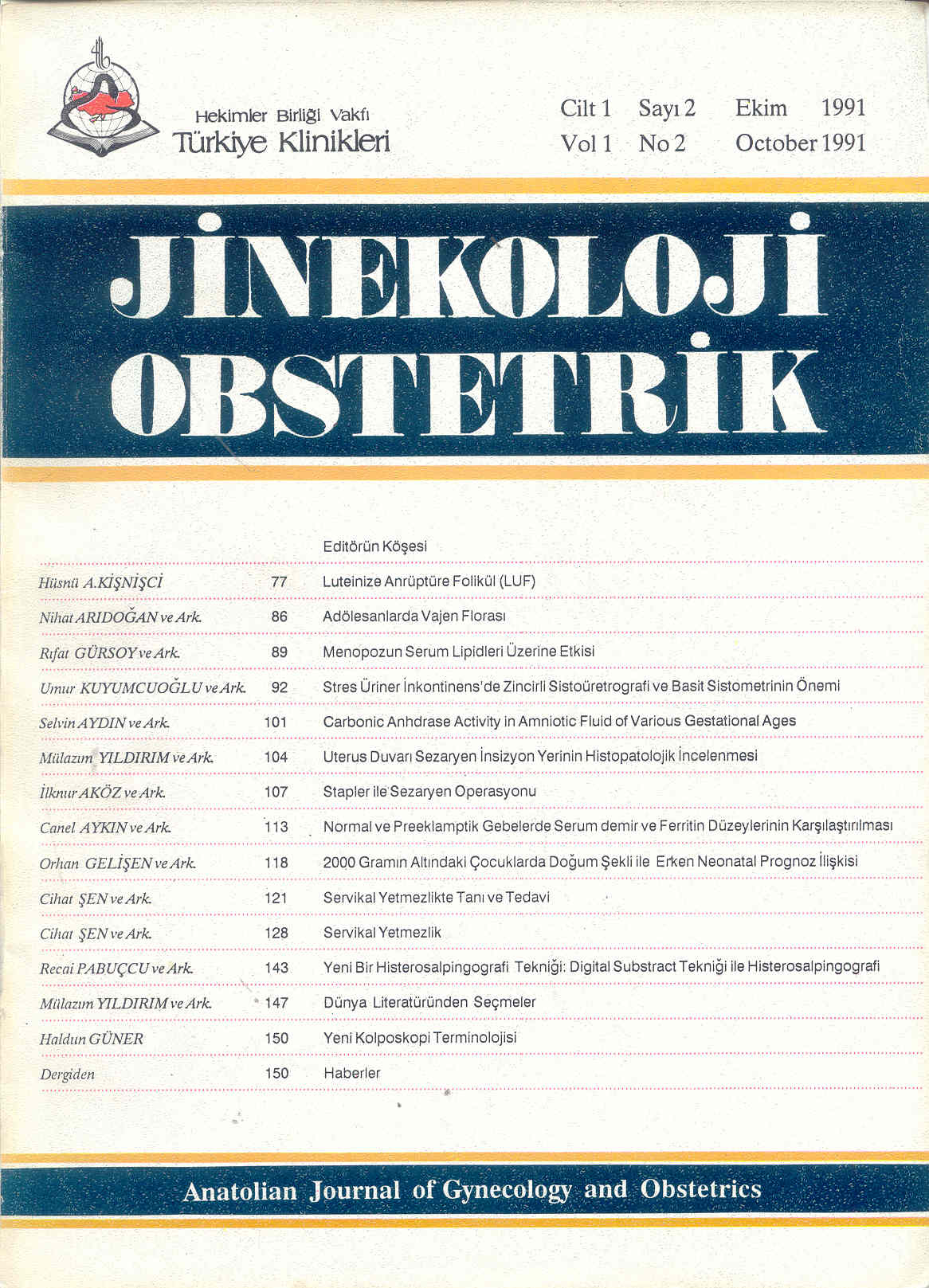Open Access
Peer Reviewed
ARTICLES
2431 Viewed2214 Downloaded
Cervical Incompetency: Diagonis And Treatment
Servikal Yetmezlikte Tanı ve Tedavi
Turkiye Klinikleri J Gynecol Obst. 1991;1(2):121-7
Article Language: TR
Copyright Ⓒ 2020 by Türkiye Klinikleri. This is an open access article under the CC BY-NC-ND license (http://creativecommons.org/licenses/by-nc-nd/4.0/)
ÖZET
Servikal yetmezlik tanısı ve tedavisi halen tartışmalı olan bir konudur. Bu nedenle 1985-1989 yıllarında servikal yetmezlik (SY) tanısı konulan 41 vaka retrospektif olarak irdelendi. McDonald serklaj uygulanan 16 vakada 16 gebelik, Shirodkar serklaj yapılan 14 vakada 15 gebelik ve abdominal serklaj uygulanan 6 vakada 7 gebelik elde edilmiş olup, 3 vaka sonraki gebeliklerinde serklaj planlandığı halde takipten çıktı ve 2 gebeye de kontrendikasyon nedeni ile serklaj yapılmayıp yatak istirahati ile izlendi. Vakalarda fetal sürvi oranı vaginal serklaj öncesi %19.2 ve abdominal serklaj öncesi %7.1 olup, bunların serklaj sonrası fetal sürvi oranı %74.1 ve %85.7 olarak tesbit edilmiştir. EN iyi başarı oranları 13-15 haftalarda uygulanan hastalarda elde edildi ve McDonald serklajın daha elverişli olduğu görüldü. Tüm vakalarda serklaj öncesi fetal sürvi %15.1 iken, başarılı gebelik oranı %75 olarak tesbit edildi (p<0.001).
Servikal yetmezlik tanısı ve tedavisi halen tartışmalı olan bir konudur. Bu nedenle 1985-1989 yıllarında servikal yetmezlik (SY) tanısı konulan 41 vaka retrospektif olarak irdelendi. McDonald serklaj uygulanan 16 vakada 16 gebelik, Shirodkar serklaj yapılan 14 vakada 15 gebelik ve abdominal serklaj uygulanan 6 vakada 7 gebelik elde edilmiş olup, 3 vaka sonraki gebeliklerinde serklaj planlandığı halde takipten çıktı ve 2 gebeye de kontrendikasyon nedeni ile serklaj yapılmayıp yatak istirahati ile izlendi. Vakalarda fetal sürvi oranı vaginal serklaj öncesi %19.2 ve abdominal serklaj öncesi %7.1 olup, bunların serklaj sonrası fetal sürvi oranı %74.1 ve %85.7 olarak tesbit edilmiştir. EN iyi başarı oranları 13-15 haftalarda uygulanan hastalarda elde edildi ve McDonald serklajın daha elverişli olduğu görüldü. Tüm vakalarda serklaj öncesi fetal sürvi %15.1 iken, başarılı gebelik oranı %75 olarak tesbit edildi (p<0.001).
ANAHTAR KELİMELER: Servikal yetmezlik, fetal sürvi, teknik
ABSTRACT
We performed therapeutic vaginal and abdominal procedures in 36 patients from 1985 to 1989. In the 41 cases, there were 38 pregnancies of 36 women who were not undergone cerclage and were 2 pregnancies in two patients who were not undergone cerclage because of bleeding and hypertension. McDonald, Shirodkar and abdominal cerclage techniques were used in 16, 15 and 6 women respectively. The cumulated preoperative fetal salvage rate was 19.2% in the vaginal cerclage group and was 7.1 in the abdominal cerclage group. By vaginal cerclage fetal survival rate has significantly increased to the rate of 74.1% (p<0.001), by abdominal procedures has increased to 85.7% (p<0.001). There were no statistically significant difference in successs rate between the major vaginal cerclage techniques. The best success rate was achieved in the group with McDonald at 13-15 weeks of gestation (p<0.001). In the group of after 16 weeks of gestation the cerclage procedures had been unsuccessful.
We performed therapeutic vaginal and abdominal procedures in 36 patients from 1985 to 1989. In the 41 cases, there were 38 pregnancies of 36 women who were not undergone cerclage and were 2 pregnancies in two patients who were not undergone cerclage because of bleeding and hypertension. McDonald, Shirodkar and abdominal cerclage techniques were used in 16, 15 and 6 women respectively. The cumulated preoperative fetal salvage rate was 19.2% in the vaginal cerclage group and was 7.1 in the abdominal cerclage group. By vaginal cerclage fetal survival rate has significantly increased to the rate of 74.1% (p<0.001), by abdominal procedures has increased to 85.7% (p<0.001). There were no statistically significant difference in successs rate between the major vaginal cerclage techniques. The best success rate was achieved in the group with McDonald at 13-15 weeks of gestation (p<0.001). In the group of after 16 weeks of gestation the cerclage procedures had been unsuccessful.
MENU
POPULAR ARTICLES
MOST DOWNLOADED ARTICLES





This journal is licensed under a Creative Commons Attribution-NonCommercial-NoDerivatives 4.0 International License.











